
Georgian architecture is the name given in most English-speaking countries to the set of architectural styles current between 1714 and 1830. It is named after the first four British monarchs of the House of Hanover—George I, George II, George III, and George IV—who reigned in continuous succession from August 1714 to June 1830. The so-called great Georgian cities of the British Isles were Edinburgh, Bath, pre-independence Dublin, and London, and to a lesser extent York and Bristol. The style was revived in the late 19th century in the United States as Colonial Revival architecture and in the early 20th century in Great Britain as Neo-Georgian architecture; in both it is also called Georgian Revival architecture. In the United States the term "Georgian" is generally used to describe all buildings from the period, regardless of style; in Britain it is generally restricted to buildings that are "architectural in intention", and have stylistic characteristics that are typical of the period, though that covers a wide range.
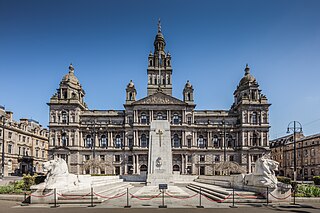
The City Chambers or Municipal Buildings in Glasgow, Scotland, has functioned as the headquarters of Glasgow City Council since 1996, and of preceding forms of municipal government in the city since 1889. It is located on the eastern side of the city's George Square. It is a Category A listed building.
Kinglassie is a small village and parish in central Fife, Scotland. It is located two miles southwest of Glenrothes. In 2011, the population of the village was 1,684.

Fraserburgh is a town in Aberdeenshire, Scotland with a population recorded in the 2011 Census at 13,100. It lies at the far northeast corner of Aberdeenshire, about 40 miles (64 km) north of Aberdeen, and 17 miles (27 km) north of Peterhead. It is the biggest shellfish port in Scotland and one of the largest in Europe, landing over 5,450 tonnes in 2016. Fraserburgh is also a major port for white and pelagic fish.

The villages of Inverallochy and Cairnbulg lie some 4 miles (6.4 km) east of Fraserburgh, in North East Scotland. It formerly consisted of the three fishing villages of Brandesburgh, Cairnbulg and Inverallochy, but the former village has since disappeared.

Kinnaird Head is a headland projecting into the North Sea, within the town of Fraserburgh, Aberdeenshire, on the east coast of Scotland. The 16th-century Kinnaird Castle was converted in 1787 for use as the Kinnaird Head Lighthouse, the first lighthouse in Scotland to be lit by the Commissioners of Northern Lights. Kinnaird Castle and the nearby Wine Tower were described by W. Douglas Simpson as two of the nine castles of the Knuckle, referring to the rocky headland of north-east Aberdeenshire. The lighthouse is a category A listed building. and the Wine Tower. is a scheduled monument. The buildings around the base of the lighthouse are the work of Robert Stevenson.

Peterhead is a town in Aberdeenshire, Scotland. It is Aberdeenshire's biggest settlement, with a population of 18,537 at the 2011 Census. It is also the largest fishing port in the United Kingdom for total landings by UK vessels, according to a 2019 survey.

Cairness House, 4 miles (6.4 km) south of Fraserburgh in the County of Aberdeenshire, is a country house in Buchan built in the Neoclassical style. It was constructed between 1791 and 1797 to designs by architect James Playfair and replaced an earlier house of 1781 by Robert Burn, which was in part incorporated into the Playfair scheme. Sir John Soane assisted in the final stages of the construction following Playfair’s death in 1794. The park was laid out by Thomas White, a follower of Lancelot 'Capability' Brown.

Strichen is a village in Aberdeenshire, Scotland. It sits on the A981, connecting it to New Deer 7.2 miles (12 km) to the southwest and Fraserburgh 8 miles (13 km) to the north-northeast, and the B9093, connecting it to New Pitsligo about 4 miles (6.4 km) due west. The village got its name from Lord Strachen. It is situated on the River Ugie at the foothills of Mormond Hill. The Strichen White Horse is constructed of quartz on Mormond Hill, some 1,500 m (1,600 yd) northeast of Strichen.
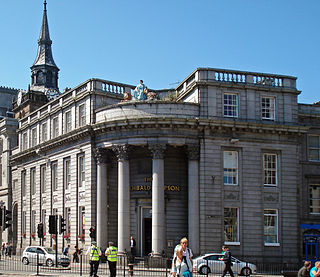
The architecture of Aberdeen, Scotland, is known for the use of granite as the principal construction material. The stone, which has been quarried in and around the city, has given Aberdeen the epithet The Granite City, or more romantically, and less commonly used, the Silver City, after the mica in the stone which sparkles in the sun.

New Pitsligo, also known as Cavoch, is a village in Aberdeenshire, Scotland, quite near Peterhead.

Cairnbulg Castle is a z-plan castle situated in Cairnbulg, Aberdeenshire, Scotland. It was described by W. Douglas Simpson as one of the nine castles of the Knuckle, referring to the rocky headland of north-east Aberdeenshire. It stands by the River Philorth and was originally known as Philorth Castle. The 17th-century Philorth Castle, an L-plan house consisting of a sizeable crow-stepped block, was demolished after a fire in 1915.

The Architects Building is an office building located at 415 Brainard Street in Midtown Detroit, Michigan. It was listed on the National Register of Historic Places in 1995.
William Smith was a Scottish architect. He was a son of John Smith, also an architect, and his mother was Margaret Grant. A partner in the Aberdonian firms J & W Smith (1845–1879), W & J Smith (1879–1887) and W & J Smith and Kelly (1887–1891), and employed as Aberdeen's superintendent of works (1852–1891), he designed a large number of buildings in north east Scotland.
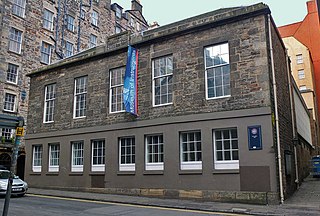
St Cecilia's Hall is a small concert hall and museum in the city of Edinburgh, Scotland, in the United Kingdom. It is on the corner of Niddry Street and the Cowgate, about 168 metres (551 ft) south of the Royal Mile. The hall dates from 1763 and was the first purpose-built concert hall in Scotland. It is a Category A listed building.

James Matthews was a prominent 19th-century architect in northern Scotland who also served as Lord Provost of Aberdeen from 1883 to 1886 during which time he enacted an important city improvement plan. His work as an architect is largely in the Scots baronial style.

Robert Gordon Wilson (1844–1931) was a 19th/20th century Scottish architect based in Aberdeen. He was from a strong United Presbyterian background and specialised in churches for the United Presbyterian Church and Free Church of Scotland.

Robert Burn (1752–1815) was a Scottish architect. He was father to the architect William Burn.
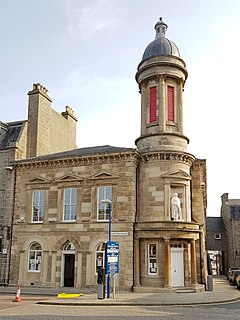
Fraserburgh Town House is a municipal building in Saltoun Square, Fraserburgh, Scotland. The building, which was the headquarters of Fraserburgh Burgh Council, is a Category B listed building.
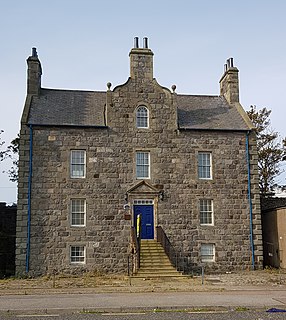
The World's End is an historic townhouse in Fraserburgh, Scotland, standing on Dalyrmple Street. Category B listed, it dates to around 1767.



















